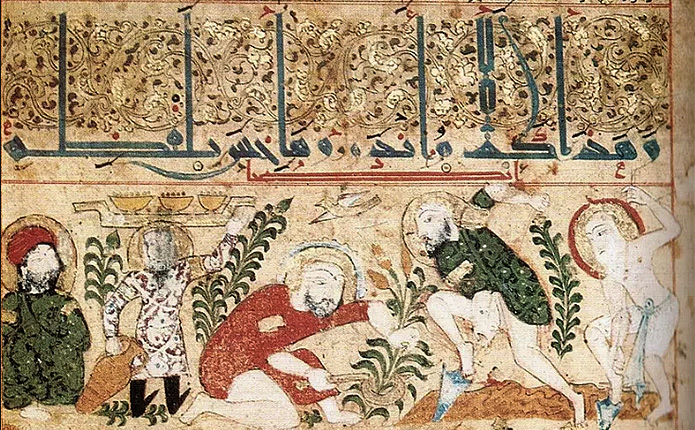 Depiction of an irrigation system being set up and used in the Islamic world
Depiction of an irrigation system being set up and used in the Islamic world
FOCUS QUESTION:
How did the Arab Agricultural Revolution transform middle eastern society in 8th to 13th centuries?
|
PAGE SUMMARY
The Arab Agricultural Revolution describes transformations in agriculture that occurred from the 8th to the 13th century.
This idea comes from an article by Andrew Watson, who claimed that a revolution in Mediterranean farming techniques began as a result of the Islamic Empire’s unification of land from modern-day Afghanistan to Spain. These techniques included irrigation technology, which resulted in an increase in crop yields. He argues that this led to the diffusion of 17 different crops. This revolution had many effects, such as changes in the economy, population levels, and diet.
It also resulted in the spread of new writing and knowledge throughout the Islamic Empire. The House of Wisdom was a library and intellectual center that was established during this time.
Jenna Boyer, February 2022
|
Image by Ahmad Y. a-Hassan from History of Science and Technology in Islam

 CROSS-LINK: Islam's Golden Age
CROSS-LINK: Islam's Golden Age
 Video Intro to the Arab Agricultural Revolution
Video Intro to the Arab Agricultural Revolution
This is a lecture given about the Arab Agricultural Revolution
https://youtu.be/Q7vuVAoSwSs
Map of the area of agricultural development over time
Click here for a Jeopardy game on the Arab Agricultural Revolution

Background on the Arab Agricultural Revolution (also known as Islamic Green Revolution)
- 8th to 13th century transformations in agriculture
- Crops and mechanization of irrigation systems
The term "Arab Agricultural Revolution", also know as the Islamic Agricultural Revolution, was first coined by Andrew Watson in an article which argued that in the 8th century up until the 13th century, the Islamic Empire's unification of land from modern-day Afghanistan to Spain, fostered a revolution in Mediterranean farming techniques.
Watson proposes a “Green Revolution that entailed the spread of intensive methods of farming and irrigation technology and a rise in crop yields because of these farming techniques".
Village scene with poultry, sheep and goats from a copy of the Maqamat al-Hariri illustrated by al-Wasiti, 1237

To support his claims, Andrew Watson advances a theory about the spread of 17 different crops, many of which are later a part of the Columbian Exchange. These crops include:
- Asiatic rice
- sugar cane
- banana
- plantain
- lemon
- lime
- durham wheat
- sorghum wheat
- eggplant
- watermelon
- mango
- spinach
- artichoke
- coconut palm

 Learning CONNECTIONS:
Learning CONNECTIONS:
Which of these Arab Revolution crops were part of the Columbian Exchange?
Which of these crops do you see in America today?
Which of these crops do you see in your own meals and homes?
In depth reading (for teachers) on the "Arab Agricultural Revolution" by Michael Decker, University of South Florida
Agricultural scene from a medieval Arabic manuscript from al-Andalus c. 1200

Article- Effects of Revolution-
- Economy
- Population distribution
- Vegetation cover
- Agricultural production and income
- Population levels
- Urban growth
- Distribution of the labor force
- Linked industries
- Cooking and diet
- Clothing
Another side effect of the Arab Agricultural Revolution is that it helped spread the production of sugarcane. The Ottoman History Podcast's episode "Legacies of al-Andalus", linked here, describes how "the plantation economy as we know it could not have existed without the knowledge of sugar cultivation adapted from the Islamic world".
Click here for a transcript of the episode.
Diverse wealth of writings and knowledge disseminated throughout Islamic Empire
Bait al-Hikma (House of Wisdom) : Intellectual center and large private library in Baghdad established by Abbasid Caliphates in the late 8th century
- The Abbasid House of Wisdom was a center of the broader Greco-Arabic translation movement
- The works of Plato, Aristotle, Pythagoras, and Hippocrates are only a few of the immensely valuable works that were translated for Arab consumption
- Many scholars contributed to fields addressed by these works and others; scholars at the House of Wisdom filled the library with works about:
- Mathematics
- The famous mathematician al-Khwarizmi worked in the House of Wisdom; his book Kitab al-Jabra is why he is know as the father of Algebra for his work with algorithms, a word for which the etymology can be traced back to his Latin name "Algorithmus"
Muhammad ibn Musa al-Khwarizmi

This is a page from Al-Khwarizmi's Al-Jabra

- Medicine
- Agriculture
- Finance
- Engineering
- Astronomy
- Many more fields
Unfortunately, the massive library was burned down in the 1258 Mongol siege of Baghdad, bringing the city to rubble and effectively ending the Abbasid Caliphate
Quiz Questions:
What group of plants/crops were provided to the Islamic world during the Arab Agricultural Revolution?
A)Tomatoes, Beans, Carrots, and Grapes
B) Broccoli, Cauliflower, Spinach, and Potatoes
C) Apples, Beats, Corn, and Asparagus
D) Sugar cane, Oranges, Bananas, and Coconuts
Answer D
These are the plants depicted in Islamic pottery and paintings during the time period. These plants also were well suited for the climate of the region, making it possible to grow crops during all seasons of the year, thus creating the crop cycle.
Question: What did NOT happen as a result of the Arab Agricultural Revolution? Explain why you chose your answer.
a. the spread of religion
b. the spread of irrigation technology
c. the spread of crops
d. the spread of writing
Answer: A is correct because the Arab Agricultural Revolution did not spread religion. It did spread 17 different crops, irrigation technology and other farming techniques, and knowledge and writing through the House of Wisdom, which means B, C, and D are incorrect since the question is asking what did NOT happen as a result of the Arab Agricultural Revolution
Comments (0)
You don't have permission to comment on this page.